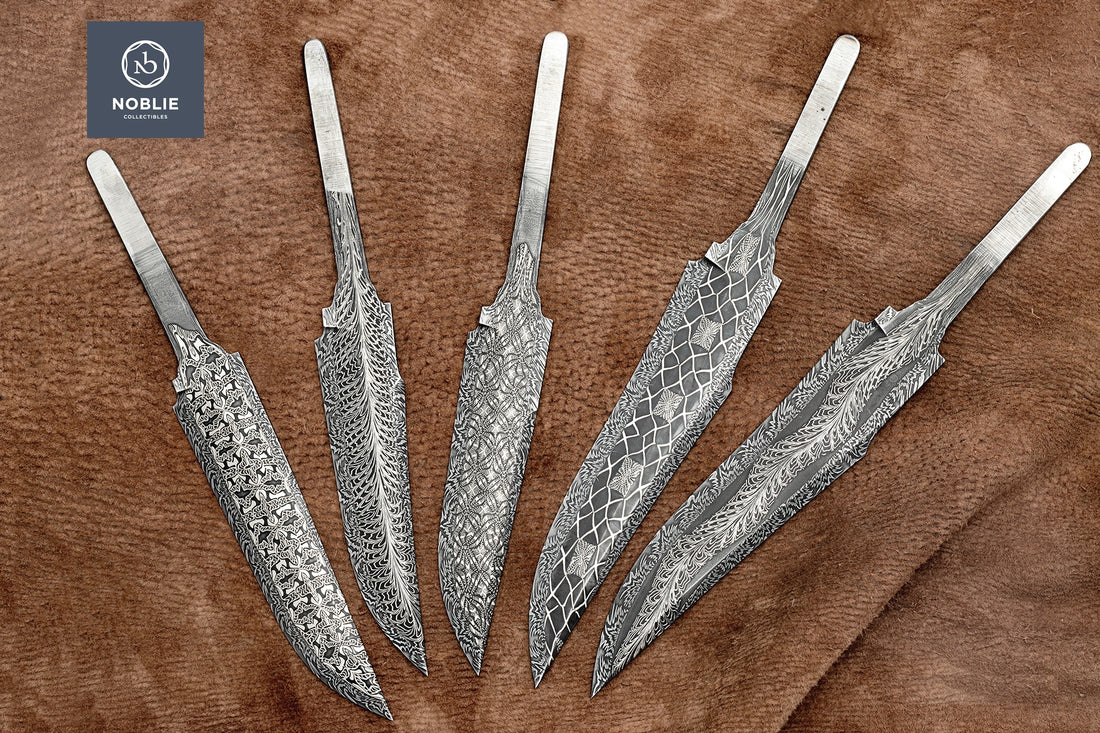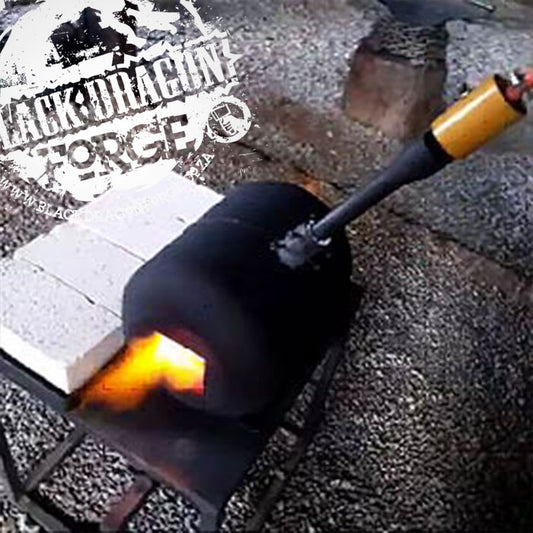
Mosaic Damascus Steel: The Perfect Choice for Custom Knives
Neels Van Den BergHow to Make Mosaic Damascus for Custom Knives
Article By Noblie Custom Knives

Mosaic Damascus steel is a specialized form of pattern-welded steel that incorporates intricate, symmetrical patterns. Unlike traditional Damascus, where patterns emerge randomly, mosaic Damascus allows you to create specific, intentional designs by carefully layering and manipulating different steels. The steel is known for its strength and striking visual appearance. It has a complex creation process that involves multiple steps of layering, welding, and forging, all designed to create a repeating, mosaic-like effect throughout the blade.
Knifemakers prize it for its visual appeal and the technical challenge it presents. Noblie Custom Knives showcases some of the finest examples of custom knife craftsmanship, with many featuring stunning mosaic Damascus blades. Each custom Damascus knife reflects the artistry and skill that go into the knife-making process.
Benefits of Using Mosaic Damascus for Knives
Mosaic Damascus steel offers several benefits for knife making, both in terms of performance and aesthetics. The unique forging process creates intricate, one-of-a-kind patterns that turn each blade into a work of art. Functionally, Mosaic Damascus combines the strength and durability of high-carbon steel with the flexibility needed for long-lasting edge retention. This fusion of metals allows for a tough, wear-resistant blade that stays sharp through heavy use. In addition, the ability to customize the mosaic patterns makes it a top choice for collectors and knife enthusiasts who value both performance and visual appeal.
Tools and Materials Needed
Before starting, you need the right materials and tools:
- Base steel: Common choices are 1095 and 15N20, providing good contrast and durability.
- Welding flux: To prevent oxidation during heating.
- Forge and anvil: For heating and forging.
- Grinders: For shaping the blade.
- Hydraulic press or power hammer: Optional but highly recommended for controlling the forging process.
- Etching solution: Ferric chloride for revealing the Damascus pattern.
- Polishing tools: To give the blade a final shine.
These tools and materials ensure that your work remains efficient and precise.
How to Forge Mosaic Damascus Steel

- Selecting the right steel types is crucial when making Mosaic Damascus. For optimal performance and aesthetics, you typically choose a combination of high-carbon steel and nickel-based steel. High-carbon steel, like 1095 or 1084, provides the hardness and edge retention necessary for a strong, durable blade. Meanwhile, nickel-based steel, such as 15N20, adds contrast and creates bright, eye-catching patterns once the blade is etched. The contrast between these two metals enhances the visual appeal of the mosaic, while the blend of properties ensures the blade performs well in both cutting and durability.
- To prepare the billet, stack alternating layers of your chosen steel types, such as high-carbon and nickel-based steel. This layering creates the foundation for the Damascus pattern. Before stacking, make sure each layer is clean and free of any debris, rust, or scale, as impurities can prevent proper forge welding and compromise the strength of the blade. Once the layers are aligned, secure them tightly to prevent shifting during the heating process. This careful preparation ensures a solid bond between the layers, which is essential for a strong and visually appealing Mosaic Damascus steel.
- Forge welding begins by heating the prepared billet in a forge to approximately 2,200°F (1,200°C), where the steel glows a bright orange. At this temperature, the steel becomes malleable enough for the layers to fuse. Remove the billet from the forge and immediately start hammering or pressing it to drive out any air and impurities between the layers, creating a strong weld. This process often requires several heating and pressing cycles to fully bond the metals and ensure there are no weak spots. Each cycle improves the integrity of the weld, laying the groundwork for a durable Mosaic Damascus blade.
- To create the intricate mosaic patterns, the billet is manipulated after the initial forge welding. This involves cutting, twisting, or reshaping the steel layers to achieve unique designs. Each manipulation step adds complexity and character to the final product, resulting in a blade with intricate, one-of-a-kind mosaic patterns embedded within the steel.
- Once the desired pattern is formed, the billet is cut and restacked to add complexity and depth to the mosaic design. By restacking the billet, you multiply the layers and enhance the intricacy of the pattern. After realigning the layers, the new stack is forge-welded once again under intense heat, fusing the pieces into a solid block of steel. This repeated process of cutting, restacking, and welding builds more intricate designs. The restocking stage refines the aesthetic qualities of the Mosaic Damascus blade.
Forging the Blade
Heating the Layered Steel to Welding Temperature. With the billet assembled, place it in your forge. You’ll need to heat it to a welding temperature—usually around 2200°F (1204°C). Watch for the steel to reach a bright orange or yellow glow. If it becomes too hot and starts sparking, you've gone too far, and the billet could be ruined.Forging the Steel into the Desired Shape. Once at welding temperature, begin forging. Start by pressing the billet lightly to ensure the layers weld together without shifting the pattern. After the initial welds, continue shaping the billet into a knife-like form, using a hydraulic press or hand hammer to refine the blade. Be cautious with your hammering technique—too much force can distort your carefully designed pattern.
Normalizing and Annealing the Steel. After forging, the steel undergoes internal stresses that need to be relieved. Normalize the blade by heating it to a critical temperature and allowing it to cool slowly. This process refines the grain structure and improves durability. Annealing will soften the steel, making it easier to grind and shape later.
Heat Treatment, Finishing and Polishing
Grinding and Shaping the Blade. Once the blade has cooled, begin the grinding process. Use a belt grinder to refine the shape and edge of the knife. Focus on maintaining the pattern and ensuring that the blade's profile is balanced. Grind slowly to avoid overheating, which could damage the pattern.Heat the forged blade to critical temperature and quench it in oil or water, hardening the steel. Temper the blade to remove brittleness and increase durability.
Etching the Damascus Pattern. To reveal the Mosaic Damascus pattern, submerge the blade in a ferric chloride etching solution. The acid will eat away at the softer steel more quickly than the harder steel, creating a high-contrast pattern. Keep an eye on the etch and adjust based on how deep and pronounced you want the pattern.
Tips and Tricks
-
Choosing the Right Welding Flux
Use a high-quality flux, such as borax-based formulas. It will ensure that oxidation doesn’t occur during welding and provides a cleaner bond between layers. For specific steel combinations, you may want to experiment with different fluxes for better results.
-
Controlling the Heat During Forging
Maintaining a consistent heat is crucial during the forging process. Too hot, and you risk burning the steel. Too cold, and the layers won’t bond properly. I find using a temperature gauge or pyrometer helps keep the temperature in the sweet spot for clean welds.
-
Etching Techniques for Different Patterns
Experiment with etching times. For a deeper, more dramatic effect, leave the blade in the ferric chloride for longer periods, but check regularly. You can also use a combination of acids for different color contrasts and texture effects.
-
Troubleshooting Common Issues
If you encounter delamination, it’s likely due to improper welding temperatures or dirty surfaces. Ensure both are corrected before attempting to forge again. Pattern distortion often results from uneven hammering, so focus on consistent, even strikes.
Conclusion
Mosaic Damascus steel combines aesthetics with functionality. Its patterns are limited only by your imagination, making it a go-to material for custom knives. The blade’s strength, toughness, and the eye-catching design make it a favorite among collectors and makers alike.
The more you experiment, the better your results will be. The process of making Mosaic Damascus is both challenging and rewarding. I encourage you to continue exploring new patterns and techniques to push the limits of what you can create with this incredible material.
Article By Noblie Custom Knives








